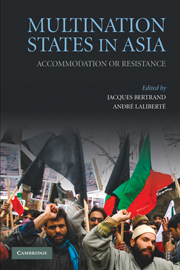Book contents
- Frontmatter
- Contents
- List of Tables and Figures
- List of Maps
- List of Contributors
- Acknowledgments
- Maps
- 1 Introduction
- 2 Revolutionary State Formation and the Unitary Republic of Indonesia
- 3 The Crisis of Border States in India
- 4 Pakistan: Neither State Nor Nation
- 5 Constitutional Politics and Crisis in Sri Lanka
- 6 The Dilemmas of Burma's Multinational Society
- 7 The Double-Edged Sword of Autonomy in Indonesia and the Philippines
- 8 China and the Virtual Taiwan Nation
- 9 The Failure of Ideologies in China's Relations with Tibetans
- 10 Leninism's Long Shadow in Central Asia
- 11 Conclusion
- References
- Index
9 - The Failure of Ideologies in China's Relations with Tibetans
Published online by Cambridge University Press: 05 June 2012
- Frontmatter
- Contents
- List of Tables and Figures
- List of Maps
- List of Contributors
- Acknowledgments
- Maps
- 1 Introduction
- 2 Revolutionary State Formation and the Unitary Republic of Indonesia
- 3 The Crisis of Border States in India
- 4 Pakistan: Neither State Nor Nation
- 5 Constitutional Politics and Crisis in Sri Lanka
- 6 The Dilemmas of Burma's Multinational Society
- 7 The Double-Edged Sword of Autonomy in Indonesia and the Philippines
- 8 China and the Virtual Taiwan Nation
- 9 The Failure of Ideologies in China's Relations with Tibetans
- 10 Leninism's Long Shadow in Central Asia
- 11 Conclusion
- References
- Index
Summary
This chapter considers China's relations with Tibet, one of the most intractable problems faced by the Chinese Communist Party (CCP) in its minority nationalities policy. Among the fifty-five minority nationalities that are recognized by Chinese officials, Tibetans come the closest to constituting a sub-state nation seeking self-determination. Like all the other groups discussed in this book, Tibetans have made demands for the protection of their language, way of life, and culture. But in this case, religion has played a major role in Tibetan national identity, and, as this chapter argues, has represented a central element of Tibetan–Chinese relations for decades, even before the CCP took power. In addition, the Chinese state, under both the Republican regime and under the CCP since 1949, has made many promises to the Tibetans that, for the most part, have not been kept.
THE CREATION OF TIBETAN NATIONALISM
Since this volume focuses on the instability of multination states, it is especially appropriate to consider the issue of Tibet as a part of China. Like the long struggles of Palestinians and Kurds, the Tibetan sub-state nationalist movement has proven to be an enduring international issue in the contemporary era. While the Chinese state has asserted the primacy of a unitary nation-state, the strong tradition of an independent narrative history of Tibet largely revolving around its distinct religio-political system (as well as the de facto Tibetan independence from 1912 to 1951) has provided a powerful intellectual resource for the current Tibetan nationalist movement.
- Type
- Chapter
- Information
- Multination States in AsiaAccommodation or Resistance, pp. 219 - 243Publisher: Cambridge University PressPrint publication year: 2010
- 1
- Cited by

